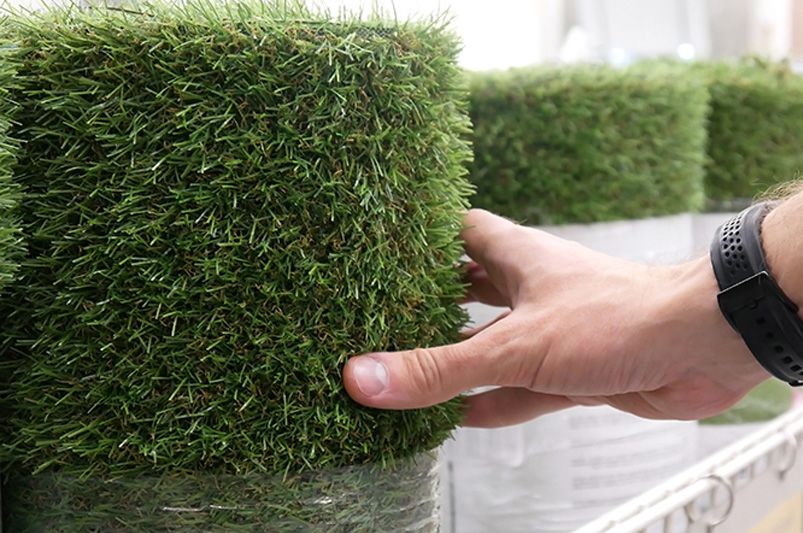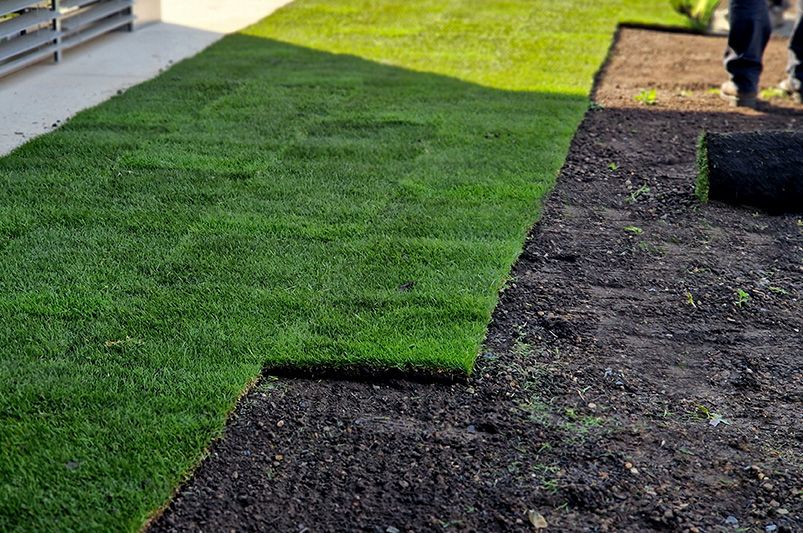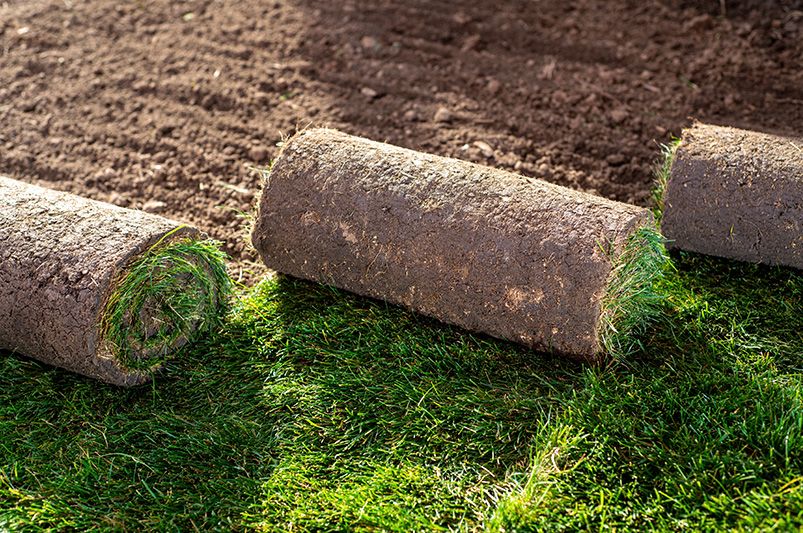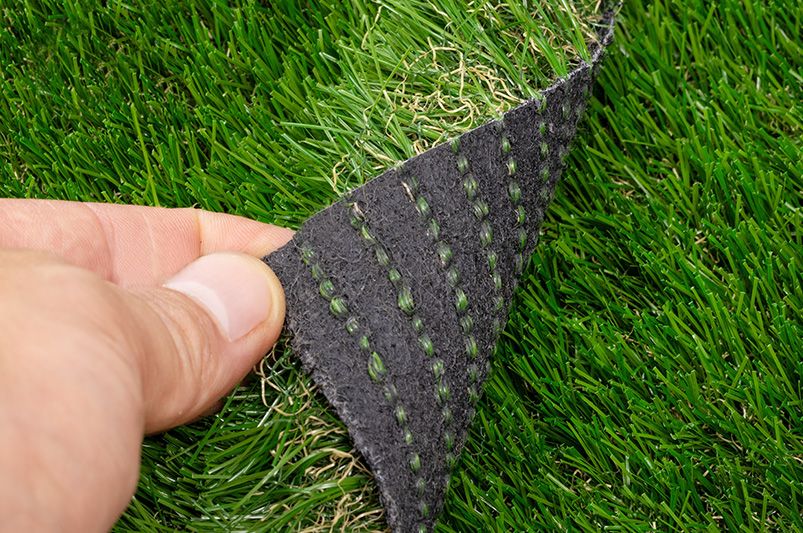
Natural Turf vs. Synthetic Turf: What’s Best for Your Yard
Published: 22/09/2024 | Updated: 20/09/2024
Synthetic Turf – The Modern Alternative
Pros of Synthetic Turf
-
Low Maintenance:
Synthetic turf requires little to no maintenance—no mowing, watering, or fertilizing. This saves time and money in the long run. -
Durability and Longevity:
High-quality synthetic grass can last up to 15 years or more, holding up well under heavy foot traffic, making it perfect for families and pets. -
Water Conservation:
Since synthetic turf doesn't need watering, it’s an eco-friendly option for areas facing water shortages or those aiming to reduce their water usage. -
All-Weather Use:
Unlike natural grass, synthetic turf isn’t affected by weather conditions. It stays green and usable throughout the year, even in extreme heat or cold.
Cons of Synthetic Turf
-
Initial Cost:
The upfront cost of installing synthetic turf is significantly higher than natural grass, although long-term savings on maintenance can offset this. -
Heat Retention:
Synthetic turf can become uncomfortably hot in direct sunlight, making it less appealing for activities during peak summer heat. -
Limited Environmental Benefits:
Unlike natural grass, synthetic turf doesn’t support local ecosystems or contribute to oxygen production and soil health.
Explore ShrubHub’s top synthetic turf options to create a beautiful, hassle-free landscape that fits your needs.
Comparing Costs and Maintenance
When deciding between natural turf and synthetic turf, understanding the costs and maintenance involved plays a critical role. Let’s break down the initial installation expenses and the ongoing care required for each option to give you a clear picture of what you're investing in over the long term.

Initial Installation Costs
Natural Turf
-
Cost of Sod/Seed:
The initial cost of installing natural turf is generally lower compared to synthetic turf. You have the option to choose between laying sod or planting grass from seed. Sod, though more expensive, provides immediate results, while seeding is cheaper but takes time to grow and establish. -
Soil Preparation and Fertilization:
Preparing the soil for natural grass includes costs for fertilization, leveling, and possibly adding topsoil to ensure a healthy root system. These expenses can vary depending on your location and soil quality. -
Irrigation System Setup:
While optional, installing an irrigation system is highly recommended for natural turf. This adds to the initial cost but ensures your lawn gets consistent watering, especially during dry spells. -
Overall Initial Cost Range for Natural Turf:
On average, homeowners can expect to spend around $1,000 to $5,000 depending on the lawn size and location.
Synthetic Turf
-
Cost of Materials:
Synthetic turf requires a more substantial upfront investment. The material itself can range from $5 to $20 per square foot, depending on the quality and type of turf. Higher-quality synthetic turfs are designed to be more realistic, durable, and soft to the touch, often with added UV resistance. -
Installation and Groundwork:
Synthetic turf installation involves clearing the area, adding a base layer of compacted gravel or sand, and then laying the artificial grass. Additional costs might include leveling the ground and creating proper drainage systems. Installation fees can vary significantly based on the complexity of the project. -
Overall Initial Cost Range for Synthetic Turf:
Synthetic turf installation typically ranges from $5,000 to $20,000 for an average yard size. This high cost is balanced out by the long-term savings in maintenance.
Lifespan and Long-Term Investment
Natural Turf
-
Lifespan:
While a well-maintained natural lawn can last indefinitely, its appearance and health are vulnerable to changing weather conditions, pests, and diseases. Regular upkeep is required to keep it looking lush and green. -
Long-Term Investment:
Over time, the maintenance costs—such as fertilizers, water bills, and lawn care services—can add up. Natural grass may need to be reseeded or resodded periodically, especially in areas that see a lot of foot traffic or harsh weather.
Synthetic Turf
-
Lifespan:
High-quality synthetic turf can last 15 to 20 years or more, making it a long-term investment. Most turf products come with warranties that ensure their durability for years to come. -
Long-Term Investment:
Despite the higher initial cost, synthetic turf offers substantial long-term savings because it requires virtually no ongoing expenses for watering, fertilization, or mowing. You may need to budget for occasional cleaning and infill replacement, but these costs are minimal compared to the continuous upkeep required by natural grass.
Ongoing Maintenance
Natural Turf
-
Watering:
One of the most significant ongoing costs for natural turf is water. To keep your grass looking green, regular watering is essential, especially during hot summer months. Depending on your climate, this can lead to high water bills, particularly if you live in a drought-prone area. -
Mowing and Trimming:
Grass must be mowed regularly, typically once a week during peak growing seasons. This requires either investing time if you're doing it yourself or paying for lawn care services. Equipment costs (mowers, trimmers) and fuel or electricity also add to the ongoing expenses. -
Fertilization and Pest Control:
Natural grass requires fertilization to remain healthy and lush. Additionally, pest control measures might be needed to prevent infestations of grubs, weeds, and other harmful pests. These maintenance tasks not only cost money but also require careful management to avoid harming the environment.
Synthetic Turf
-
Cleaning:
One of the main advantages of synthetic turf is that it requires little maintenance compared to natural grass. However, to keep it looking fresh, occasional cleaning may be necessary. Debris like leaves and dirt can accumulate, so using a leaf blower or rinsing it with water can help maintain its appearance. -
Infill Replenishment:
Over time, the infill material (usually sand or rubber) that helps support the blades of synthetic turf may need to be replenished. This is typically done every few years, depending on how much wear and tear the turf experiences. -
No Mowing or Watering:
Synthetic turf eliminates the need for mowing, fertilization, and watering, making it a highly convenient option for those seeking a low-maintenance lawn. The savings on time and water make it particularly attractive for homeowners looking for a long-term solution.
Both natural and synthetic turf come with their unique costs and maintenance needs. While synthetic turf has a high initial price, its minimal upkeep makes it a popular option for those who prefer convenience. On the other hand, natural turf offers the charm of real grass but demands continuous care and resources.
Explore ShrubHub’s range of lawn solutions, whether you're interested in the beauty of natural turf or the simplicity of synthetic grass. Our experts can guide you in choosing the best option for your home.

Environmental Impact
When comparing natural turf to synthetic turf, it's essential to consider the environmental implications of each. While both options have their respective advantages and disadvantages, understanding their overall impact on the environment can help homeowners make informed choices.
Natural Turf’s Environmental Role
Carbon Absorption and Oxygen Production
Natural grass lawns play an active role in improving air quality. Through the process of photosynthesis, grass absorbs carbon dioxide (CO₂) and releases oxygen back into the atmosphere. This contributes to reducing the overall carbon footprint, making natural turf a key player in air purification, especially in urban areas.
-
Soil Health:
Natural turf promotes biodiversity, encouraging healthy microbial activity in the soil. The grass roots help prevent soil erosion, improve water infiltration, and increase soil fertility. -
Cooling Effect:
A natural lawn can help lower temperatures around your home. Grass surfaces are cooler than synthetic ones, absorbing less heat during hot days, which benefits the surrounding environment and reduces the urban heat island effect.
Challenges with Water Use and Pesticide Runoff
While natural turf offers several environmental benefits, it also presents challenges, particularly regarding water usage. Lawns often require substantial irrigation to remain lush, especially in dry or arid regions. This heavy water consumption can strain local resources and contribute to water shortages.
-
Water Waste:
Maintaining a healthy natural lawn often requires significant water usage. In drought-prone areas, this can lead to over-reliance on irrigation systems and potentially result in water waste. -
Chemical Use and Runoff:
The use of fertilizers, herbicides, and pesticides to maintain a green lawn introduces harmful chemicals into the environment. These chemicals can seep into the groundwater, rivers, and lakes, contributing to water pollution and harming aquatic ecosystems.
Synthetic Turf’s Environmental Considerations
Manufacturing Process and Disposal
While synthetic turf eliminates the need for water, fertilizers, and pesticides, its environmental impact during the manufacturing and disposal stages is significant. The production of synthetic turf involves petroleum-based materials, which contribute to greenhouse gas emissions. Moreover, disposal at the end of its life cycle poses environmental concerns.
-
Plastic Production:
Synthetic turf is made from plastic, which requires fossil fuels for its production. This contributes to pollution and the depletion of natural resources. The manufacturing process emits carbon dioxide and other pollutants, adding to global warming concerns. -
End-of-Life Disposal:
Once synthetic turf reaches the end of its lifespan (typically 15-20 years), it must be disposed of. The turf is not biodegradable and often ends up in landfills, contributing to plastic waste. While some efforts are being made to recycle old turf, the process is still limited, making disposal a key environmental concern.
The Potential for Water Conservation
Despite its environmental downsides, synthetic turf offers a significant advantage in terms of water conservation. Unlike natural grass, synthetic turf requires no irrigation, making it an eco-friendly choice in regions facing water scarcity.
-
Water Savings:
Homeowners who switch to synthetic turf can dramatically reduce their water consumption. This is especially beneficial in areas where water restrictions are common, or in regions experiencing prolonged droughts. -
No Need for Harmful Chemicals:
Another environmental benefit of synthetic turf is that it doesn’t require the use of pesticides, herbicides, or fertilizers. This helps reduce the chemical runoff that can contaminate local water sources and harm wildlife.
In Summary, Both natural and synthetic turf offer distinct environmental pros and cons. Natural turf helps reduce carbon emissions, produces oxygen, and supports soil health, but its heavy water usage and reliance on chemicals present challenges. On the other hand, synthetic turf conserves water and avoids harmful chemical runoff, but its production and disposal have their own environmental costs.
At ShrubHub, we understand the importance of sustainable landscaping choices. Whether you choose natural turf or synthetic grass, our experts can help you make an eco-friendly decision that suits your home’s needs. Check out our weekly blog for more landscaping tips and advice.





